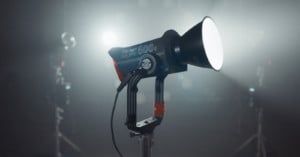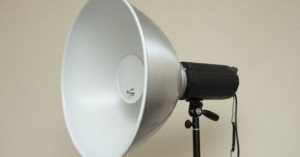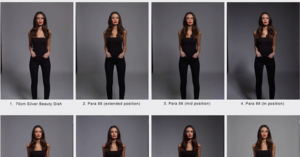
Fotodiox’s DLX Parabolic Focusing Softbox Is a Hybrid Modifier
Fotodiox has announced the DLX Parabolic Focusing Softbox, a new hybrid softbox/reflector that provides photographers extensive control over the direction and quality of their light.

Fotodiox has announced the DLX Parabolic Focusing Softbox, a new hybrid softbox/reflector that provides photographers extensive control over the direction and quality of their light.

Westcott recently released its third version of the popular specialist tool, the Eyelighter. If you happen to be a working headshot or portrait photographer, there is no way you haven’t seen it, thought about buying it, or even had it in your shopping cart at some point.

Aputure has announced the LS 600D LED point source light, a scaled-down version of its LS 600D Pro. It packs the same punch, but drops a few of those "pro" features in exchange for a more approachable price.

We all love soft light because it adds that dreaminess to food and drink photos that will always be great. However, recently I have been seeing more people use hard light in their food and drink photography.

Food photographer Joanie Simon of The Bite Shot has put together a helpful tutorial that shows you how to capture "dramatic food photography" using an extremely cheap DSLR. Specifically, she picked up a used Canon Rebel T2i with a kit lens for just $200.

Rogue has announced the latest version of its FlashBender shapeable reflectors and softboxes. Version 3 features a number of improvements over the previous iteration, including improved grip and shapeability.

Here's a handy trick that may be useful for beginning photographers: did you know that you can bend your reflector to change the quality of the light on your subject?

Here's an inspiring 5-minute behind-the-scenes video by photographer Irene Rudnyk, who shot a series of gorgeous portraits in a bedroom using only natural light and a reflector. This video shows what if you don't have pricey lighting equipment, you can still do quite a bit with just window light and some creativity.

Here's a quick tip that will save every newbie photographer (and probably more than a few intermediate shooters) some agony and embarrassment: how to properly fold a reflector in one easy motion.

Here's a quick DIY build for cash-strapped studio photographers who are sick of gaffer's tape-ing their reflectors to light stands. YouTuber Joe Edelman will show you how to build not one, but two DIY studio reflector holders for 10 bucks total.

Carrying a reflector around town with you is useful, it's just not usually practical. That's where the new Flash Bag comes in. This creatively designed camera bag comes with a reflector build right into the bag itself—just open it up.

The German light modifier company Sunbounce today announced a new product called the Tight-Fit Screen. It's a simple reflector surface that can be stretched over an existing 2-in-1 Sun-Mover reflector to provide a 3rd surface.

This is the cheapest yet most effective photography hack I can think of. Step one: get disc reflector. Step two: cut lens-sized hole in said reflector. Step three: profit.

After sharing his DIY square "ring light" build here back in July, photographer Isiah Xiong is back again with another DIY project. This time, Xiong is explaining how he built a DIY version of the $300 the Eyelighter reflector for around $40 to $50 in materials.
You can find the step-by-step tutorial in the 3-minute video above.

Whether you are shooting outside or in a studio, reflectors help you make sure that light is hitting your subject exactly how you want it. Typically, reflectors will have a silver side and a white side for varying intensities of light -- they can also cost quite a bit of money. This short video by photographer JP Morgan of The Slanted Lens shows how you can go with a cheaper DIY solution.

If you thought the Selfie Arm was a strange idea, check this out: the SelfiePICTEE is a T-shirt that has a fold-down bounce reflector on the front that provides a quick fix for the harsh shadows on your face when snapping a selfie.

Meet the Omega, the world's first 10-in-1 shoot through reflector. Designed by photographer Jerry Ghionis and manufactured by Westcott, the product has removable center panel that allows you to use it like you would a giant beauty dish or ring flash.

If you happen to have an old studio light sitting around, or you've found a set on Craigslist you’d like to pick up, we found a clever DIY hack that you should take a look at. Put together by Instructables user gmjhowe, the hack uses an IKEA lampshade and the bottom of a coffee tin to make a basic, but impressive, reflector.

Reflectors are one of the most affordable pieces of gear a photographer can have in their bag. They’re not only small in size (and usually foldable), they're also versatile and provide benefits when using both natural and artificial light.

A few weeks ago, we shared a video by photographer Karl Taylor that gave you a behind the scenes look at what a day-long fashion shoot in his studio was like. And even though a few of our readers poked fun at the video's obvious product placement, a lot of people learned a thing or two and came back with followup questions regarding the light modifiers that Taylor was using throughout the day.
Fortunately for us, Taylor was listening, and has produced this very informative follow-up video in which he discusses the differences between his go-to modifiers, complete with side-by-side comparisons.

Here's a cheap, long-lasting DIY option for those of you in need of another backdrop and/or reflector for your studio shoots. Put together by photographer Tiffany Angeles, this short video shows you all of the materials you'll need to create your own sturdy backdrop/reflector combo in the comfort of your own home.

The SquareBounce is a pretty innovative rethink of the traditional collapsible reflector used by photographers everywhere. Shaped like a "flat umbrella," it's easier to hold and orient in almost any photography situation and, as their website points out, it can actually double as an umbrella if need be.

Want to capture some wind-blown hair in a portrait photograph but don’t have access to an electric fan or …

Want to improve the quality of the photos captured using your DSLR's popup flash? Tina (AKA synthetic_meat) discovered that the cardboard box that came with a particular brand of chocolate had a nice silver lining on the inside -- perfect for making a mirrored bounce reflector! After some cutting, scoring, and folding, she came up with a DIY Lightscoop clone that lets you bounce your onboard flash off the ceiling or wall for softer and more appealing images. You can download the free template to make your own in both A4 and Letter formats.

Here’s a short video in which photo instructor Bryan Peterson shows how you can use sunlight and a simple …

Here’s a helpful tutorial that teaches how to shoot in harsh, midday sunlight using a single reflector to soften …

If you need a cheap way to bounce some light, don’t want to spend a wad of cash on …

If you’ve ever found folding up a reflector to be difficult, here’s a short and sweet video tutorial on …

Want to print your own flash reflector? Pieroway has free PDF templates that you can use. The templates print double sided, with black printed on one side and faint gray fold lines printed on the other. Print it, cut the shape out, fold along the lines, and attach it to your flash with a rubber band.

If you want a reflector to play with lighting, but don’t want to shell out money for a real one, …